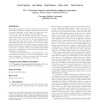Free Online Productivity Tools
i2Speak
i2Symbol
i2OCR
iTex2Img
iWeb2Print
iWeb2Shot
i2Type
iPdf2Split
iPdf2Merge
i2Bopomofo
i2Arabic
i2Style
i2Image
i2PDF
iLatex2Rtf
Sci2ools
SIGCOMM
2004
ACM
2004
ACM
Link-level measurements from an 802.11b mesh network
This paper analyzes the causes of packet loss in a 38-node urban multi-hop 802.11b network. The patterns and causes of loss are important in the design of routing and errorcorrection protocols, as well as in network planning. The paper makes the following observations. The distribution of inter-node loss rates is relatively uniform over the whole range of loss rates; there is no clear threshold separating “in range” and “out of range.” Most links have relatively stable loss rates from one second to the next, though a small minority have very bursty losses at that time scale. Signal-to-noise ratio and distance have little predictive value for loss rate. The large number of links with intermediate loss rates is probably due to multi-path fading rather than attenuation or interference. The phenomena discussed here are all well-known. The contributions of this paper are an understanding of their relative importance, of how they interact, and of the implications for MAC and routing...
| Added | 30 Jun 2010 |
| Updated | 30 Jun 2010 |
| Type | Conference |
| Year | 2004 |
| Where | SIGCOMM |
| Authors | Daniel Aguayo, John C. Bicket, Sanjit Biswas, Glenn Judd, Robert Morris |
Comments (0)

